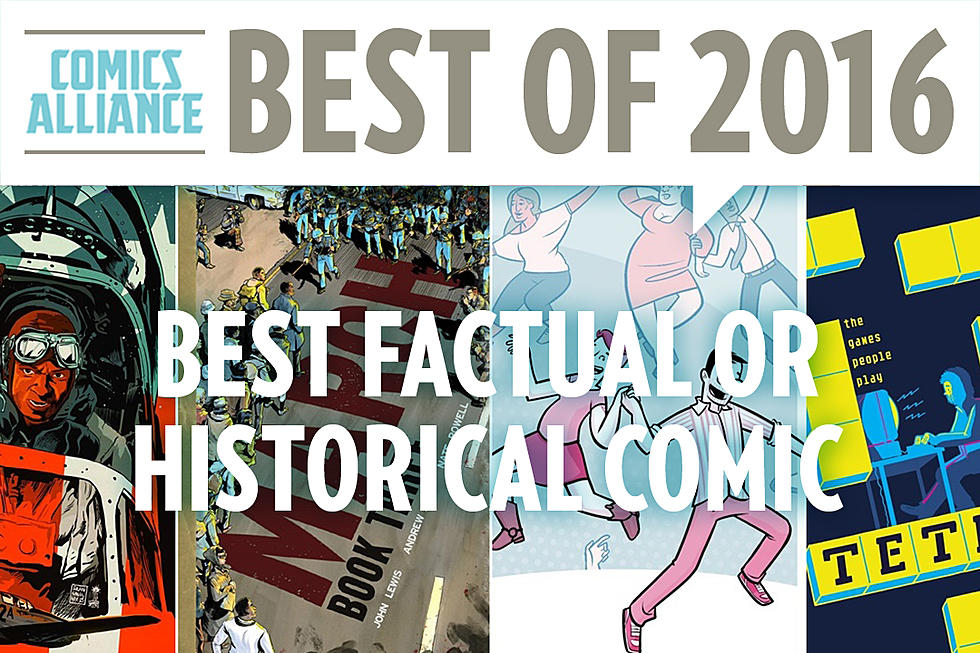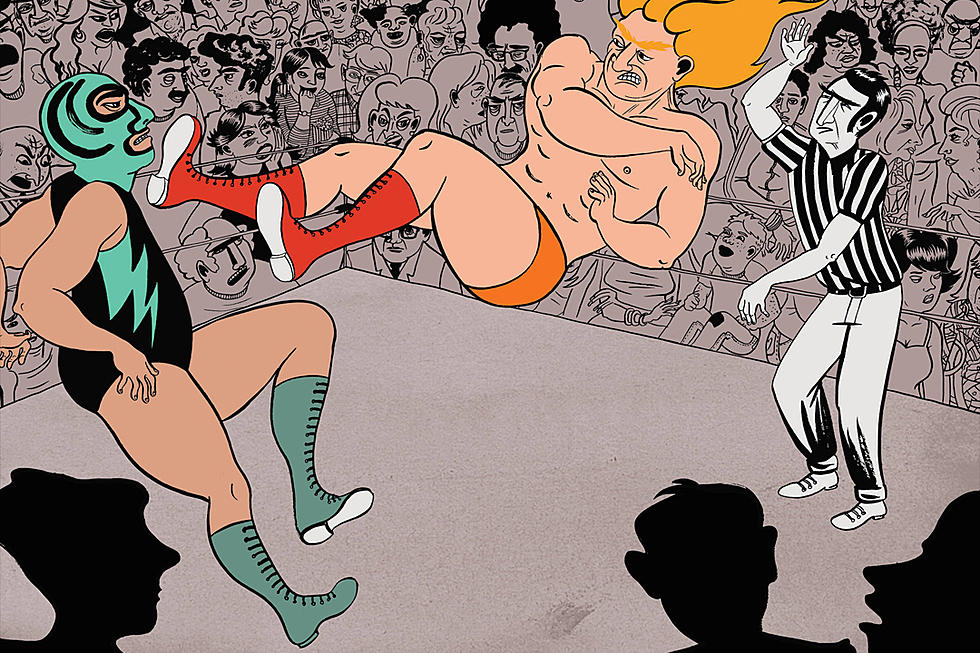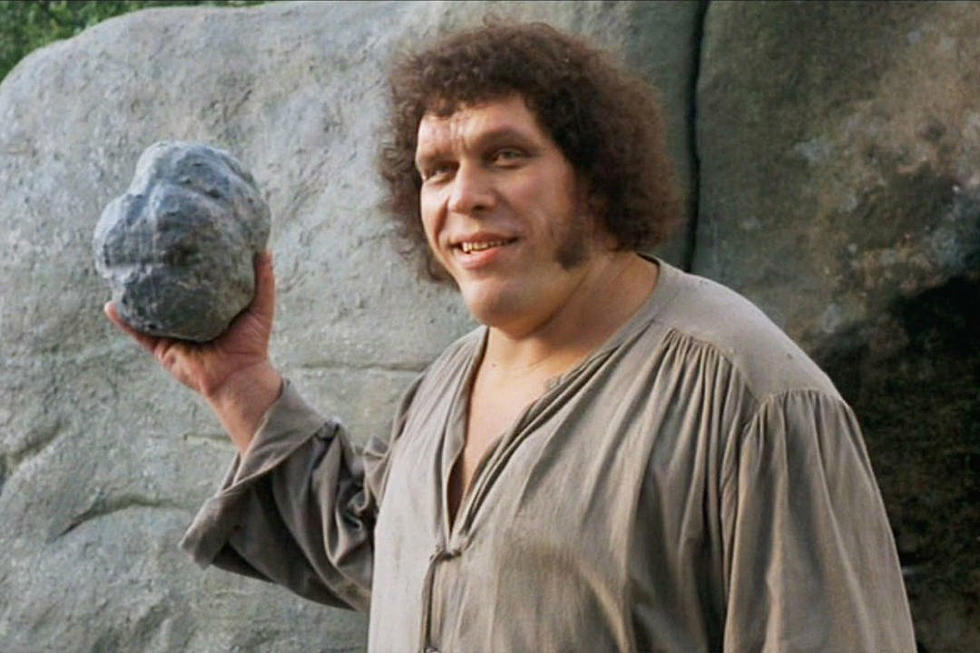
‘Andre The Giant’ Cartoonist Box Brown Talks Wrestling, Fact-Checking, And Adapting Real Life For Comics

Earlier this year, First Second released Box Brown's Andre The Giant: Life And Legend – a graphic novel biography of the wrestling legend that immediately jumped onto the New York Times bestseller list, and has been met with great acclaim from wrestling fans and comics critics alike. Our own Chris Sims described the book thusly:
"It shows Andre as a person. Not the giant with a dubious fifteen-year undefeated streak, not as the monster who was bodyslammed by Hulk Hogan at WrestleMania III, not as the absent father that was put on blast by A Current Affair shortly before his death, and not even as the drinker and prankster behind the scenes in the world of wrestling. It shows him as all of those, as a person whose life was larger than everyone’s, but whose flaws were no bigger or smaller than anyone else’s. It makes the Giant relatable without ever undermining him. There’s a love in this book, but there’s an honesty, too, and it comes through in every scene..."
Recently, we got the chance to sit down and speak with Brown about the culture of professional wrestling, his artistic approach to comics, and how he went about adapting Andre's outsized life for a graphic novel.
ComicsAlliance: What inspired you to take the Andre the Giant story and present it in comic form?
Box Brown: I had been working on this series called Everything Dies, and it was basically me doing non-fiction essays, responding to religion and stuff like that, and I really got into this ideas of telling factual stories via comics. I think comics is a really good way to talk about skepticism and atheism and things like that… it was easy to tell those stories, and I think helpful to some people to tell them in comic form. Using visuals makes it easier to break stuff down, and makes it somewhat easier to understand. I was doing that, and I had finished the series, and then one day found myself online looking up wrestling stuff, and found myself on Andre the Giant's Wikipedia page and read that he got a ride to school from Samuel Beckett. I didn't know much about that story, so I originally did a comic where it was like, Andre the Giant and Samuel Beckett…what would they talk about? And I made that into a mini-comic.
Then, the more I read about Andre, there were just so many interesting stories about him! I remember I had seen this documentary in the early 2000s about his life, so from that, I knew his story was possibly tragic. He died really young, he was disabled, and in a lot of pain all the time. So going from a semi-fictional Samuel Beckett story, I was just like: why make up anything – there's just so much actual good stuff that seems fantastical!
And the next thing you know I was a hundred pages deep into an Andre the Giant biography, and I was talking with Calista [Brill, editor at First Second]. I had talked with First Second about Everything Dies, and it didn't really work out – but then I sent them this, and they were into the idea, and next thing you know I'm Andre's biographer.
CA: How did it go from there? Did Calista and First Second offer input and suggestions, or did you just make the book, present it to them, and say "here it is"?
BB: No, because I had only done a hundred pages at that point, and I wanted to flesh it out more. I ended up re-drawing a lot of what I had done, going back and really making sure I was getting the facts as straight as I could. But it was great working with Calista, because she didn't really know that much about wrestling, so any time I would stray into these areas where I was getting far too technical for the average person, she'd be able to pull it back. She made it so anyone could pick it up and understand it. Because when you see a wrestler on a stage or in the ring, the average person, and even most fans, you don't really understand exactly what they're doing up there. Like, if you see a comedian, you can kind of see how they work and get an idea of what they're going. When you see a wrestler, the object of what they're doing and how they're doing it is so hidden from the audience.
CA: In many ways, wrestling is actually closer to a magic act than it is to most other types of performance.
BB: Yeah, so I wanted to break that down; what is the sleight of hand, what are the motivations, so people can get an idea of what a pro wrestler is, what a pro wrestler does, and what Andre was doing all this time for 30-odd years.
CA: When you're dealing with a story like this, that has a lot of real life figures in it, do you go through a lot of design drafts? You're taking those people, and depicting them in your own style, but you still need to make sure they're recognizable.
BB: It's funny. I'm a self trained, autodidactic artist, so all I was ever trying to do was to draw as realistically as possible – but that's what comes out, because I don't really know how to draw! I think when I draw characters, I'm able to reduce them down to little marks that capture the most distinct elements of them.
I work pretty quickly. I'd probably draw somebody once or twice in pencil, then just go to ink. Not really care too much about it, and it just kind of worked out. Anytime I draw anything, it's funny, you start drawing the characters one way and then you slowly refine it throughout the book. And then, a lot of times you have to go back and redraw the first page, because the character has slowly turned into something else that looks similar but you've figured out a better way to do it.
There were other things that were difficult, though. In pro wrestling, everyone's lying to each other. You're lying to the audience, you're lying to the bosses, you're working each other. It's all this weird circle of lies. So, trying to decipher among that, and sift through all these stories and figure out: alright, that's probably not true; this is probably true; this sounds like a myth; and this is what actually happened. That was difficult.
CA: You said this started out as a mini-comic idea, and then you were able to expand it to a full length thing – but you were still condensing an entire life down to X number of pages, and having to create a cohesive story arc. Were there any particular good anecdotes or details that you wanted to throw in but weren't able to, for space or narrative reasons?
BB: I feel like there were a decent amount of stories that I didn't include for different reasons. There are stories that they tell about him in Japan... he couldn't fit in the bathroom in Japan. So he'd use the bathtub or the floor. I think that it ultimately is really interesting, and says a lot about what it was like to be disabled in the way that Andre was – but, it was also gross and unnecessary to go into him pooping on the floor.
Really, I was searching for as much material as possible, and there was stuff that I couldn't get into because I was unable to access it. If I was able to talk to a few more people that I really would have loved to get in touch with, I maybe could have expanded it in a more meaningful way. But I was happy with what I was able to extract from just talking to a few people, and from existing material about him.
CA: How much research did you do or were you able to do? Did you do a lot of interviews?
BB: There were a couple of individual interviews. I was able to talk to Bill Eadie, who was a wrestler and worked with Andre. He was really great if I had concerns. He was very generous to allow me to email him and ask him what he thought about a story, and if it was real. He was kinda like my man on the inside that way.
And I also talked to Bob Windham, his wrestler name was Blackjack Mulligan – he and Andre got into a fist fight one time, but he had already told that story in a visual interview and in his own book. But I was also able to talk to him and kind of corroborate the story a little. Though still, I feel like - he's a wrestler, he's going to continue to work the crowd, and I kinda think that's how he saw me.
CA: Well, on an artistic level, when you're dealing with telling a story like this, you need to determine what is strictly factual, and what best expresses the truth. When you're adapting a story, you make choices that will tell the reader about the characters, and the reality they occupied. Were there points in this where you went with a possibly apocryphal story, or where you needed to combine and streamline elements to get a point across?
BB: Yeah, there's definitely one long sequence in the book that's kind of a mixture of five different wrestlers' stories about Andre that I kind of condensed into one sequence, as if they were all together. All the things in that sequence all happened, but just not at the same exact time. I was very influenced by documentary film, and a lot of my favorite documentaries, they aren't pushing any kind of particular agenda. They are displaying the facts and allowing the audience to make their own decision about what they're looking at. The one thing in my book, you never really get to see inside the head of Andre, because I wasn't in his head. And I didn't talk to him. We can see what his behavior was, and we can guess what he may have been thinking, but your guess is as good as mine either way. That was a specific artistic choice.
More From ComicsAlliance
![Hanging Out With Flair, Being Best Friends With ‘The King': Mike Kingston’s Absurd Journey to ‘Headlocked: The Hard Way’ [Interview]](http://townsquare.media/site/622/files/2017/03/HTHW-Promo-2.jpg?w=980&q=75)








